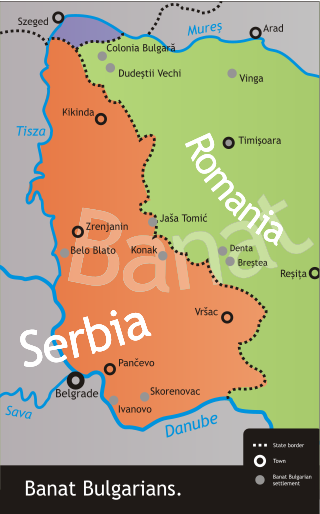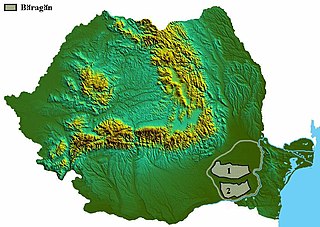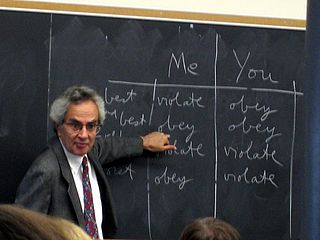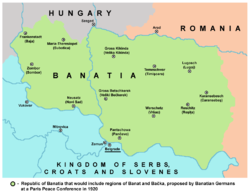
In Nazi German terminology, Volksdeutsche were "people whose language and culture had German origins but who did not hold German citizenship". The term is the nominalised plural of volksdeutsch, with Volksdeutsche denoting a singular female, and Volksdeutscher, a singular male. The words Volk and völkisch conveyed the meanings of "folk".

Banat is a geographical and historical region that straddles Central and Eastern Europe. It is currently divided among three countries: the eastern part lies in western Romania ; the western part of Banat is in northeastern Serbia ; and a small northern part lies within southeastern Hungary.

Demographics of the Socialist Federal Republic of Yugoslavia, during its existence from 1945 until 1991, include population density, ethnicity, education level, health of the populace, economic status, religious affiliations and other aspects. During its last census in 1991, Yugoslavia enumerated 23,528,230 people. Serbs had a plurality, followed by Croats, Bosniaks, Albanians, Slovenes and Macedonians.

The Danube Swabians is a collective term for the ethnic German-speaking population who lived in Kingdom of Hungary of east-central Europe, especially in the Danube River valley, first in the 12th century, and in greater numbers in the 17th and 18th centuries. Most were descended from earlier 18th-century Swabian settlers from Upper Swabia, the Swabian Jura, northern Lake Constance, the upper Danube, the Swabian-Franconian Forest, the Southern Black Forest and the Principality of Fürstenberg, followed by Hessians, Bavarians, Franconians and Lorrainers recruited by Austria to repopulate the area and restore agriculture after the expulsion of the Ottoman Empire. They were able to keep their language and religion and initially developed strongly German communities in the region with German folklore.

The Banat Republic was a short-lived state proclaimed in Timișoara c. 31 October 1918, during the dissolution of Austria-Hungary. The Republic claimed as its own the multi-ethnic territory of the Banat, in a bid to prevent its partition among competing nationalisms. Openly endorsed by the local communities of Hungarians, Swabians and Jews, the German-speaking socialist of Jewish origin Otto Roth served as its nominal leader. This project was openly rejected from within by communities of Romanians and Serbs, who were centered in the eastern and western halves of the region, respectively. The short-lived entity was recognized only by the neighboring Hungarian Republic, with which it sought a merger. Its military structures were inherited from the Common Army, and placed under the command of a Hungarian officer, Albert Bartha.
About 9.3% of Romania's population is represented by minorities, and 13% unknown or undisclosed according to 2021 census. The principal minorities in Romania are Hungarians and Romani people, with a declining German population and smaller numbers of Poles in Bukovina, Serbs, Croats, Slovaks and Banat Bulgarians, Ukrainians, Greeks, Jews, Turks and Tatars, Armenians, Russians, Afro-Romanians, and others.

The Banat Bulgarians, also known as Bulgarian Roman Catholics and Bulgarians Paulicians or simply as Paulicians, are a distinct Bulgarian minority group which since the Chiprovtsi Uprising in the late 17th century began to settle in the region of the Banat, which was then ruled by the Habsburgs and after World War I was divided between Romania, Serbia, and Hungary. Unlike most other Bulgarians, they are Roman Catholic by confession and stem from groups of Paulicians and Roman Catholics from modern northern and northwestern Bulgaria.

Knićanin is a village in Serbia. It is located in the Zrenjanin municipal area, in the Banat region, Vojvodina province. Its population is 2,034 and most of its inhabitants are ethnic Serbs (97.39%).

The Banat was a political entity established in 1941 after the occupation and partition of Yugoslavia by the Axis Powers in the historical Banat region. It was formally under the control of the German puppet Government of National Salvation in Belgrade, which theoretically had limited jurisdiction over all of the Territory of the Military Commander in Serbia, but all power within the Banat was in the hands of the local minority of ethnic Germans (Volksdeutsche). The regional civilian commissioner and head of the ethnic German minority was Josef Lapp. Following the ousting of Axis forces in 1944, this German-ruled region was dissolved and most of its territory was included into Vojvodina, one of the two autonomous provinces of Serbia within the new SFR Yugoslavia.

German Hungarians are the German-speaking minority of Hungary, sometimes also called Danube Swabians, many of whom call themselves "Shwoveh" in their own Swabian dialect. There are 131,951 German speakers in Hungary. Danube Swabian is a collective term for a number of German ethnic groups who lived in the former Kingdom of Hungary, including the Kingdom of Croatia-Slavonia and Vojvodina. Other ethnic German groups previously lived on the territory of both the former Hungarian kingdom as well as on the territory of present-day Hungary since the Middle Ages onwards, most notably in Budapest but not only.

The Germans of Yugoslavia is a term for German-speakers who form a minority group in former Yugoslavia, namely Croatia, Serbia, Bosnia and Herzegovina or Slovenia. Despite the name for the group, the label includes ethnic Germans, primarily Danube Swabians, and Austrians. The largest German minority was found in Serbia prior to dissolution of Yugoslavia.

Gakovo is a village in Serbia. It is situated in the Sombor municipality, in the West Bačka District, Vojvodina province. The village has a Serb ethnic majority and its population is 2,201.

Kljajićevo is a village in Serbia. It is situated in the Sombor municipality, in the West Bačka District, Vojvodina province. The village has a Serb ethnic majority and its population numbered 6,012 people.

The Bărăgan deportations were a large-scale action of penal transportation, undertaken during the 1950s by the Romanian Communist regime. Their aim was to forcibly relocate individuals who lived within approximately 25 km of the Yugoslav border to the Bărăgan Plain. The deportees were allowed to return after 1956.

Glogonj is a village in Serbia, situated in the South Banat District of the province of Vojvodina. It is located on the banks of the Tamiš River, about 20 kilometers northwest of Pančevo, and about 20 kilometers direct north of Belgrade. It has a Serb ethnic majority, numbering 2,657 people as of 2022. Its neighboring villages are Sefkerin to the north and Jabuka to the south. All of them lie on the Tamiš.
The presence of German-speaking populations in Central and Eastern Europe is rooted in centuries of history, with the settling in northeastern Europe of Germanic peoples predating even the founding of the Roman Empire. The presence of independent German states in the region, and later the German Empire as well as other multi-ethnic countries with German-speaking minorities, such as Hungary, Poland, Imperial Russia, etc., demonstrates the extent and duration of German-speaking settlements.

Stefan Jäger was a painter known for his depiction of and deep identification with the Danube Swabian community to which he belonged.

The Germans of Serbia are an ethnic minority of Serbia which numbers 2,573 people according to the last population census from 2022. The Germans of Serbia usually refer to themselves as Swabian, and they are grouped into the Danube Swabians or Banat Swabians in the Vojvodina region, where the majority of the population resides. Germans settled parts of Serbia in the late 17th century during Habsburg administration. The German population of Vojvodina was more numerous in the past.

Josef Lapp was a Danube Swabian and was the vice banus of Banat from 1941 until 1944.

Count, Karl von Möller AOL O was an officer, journalist, author and politician from Banat. He was an enthusiastic supporter of Hitler's National Socialism. In 1932, he published the antisemitic newspaper "Der Stürmer" in Timișoara, an imitation of the German Nazi publication. He was married to Margarete Jung, with whom he had two children.
























